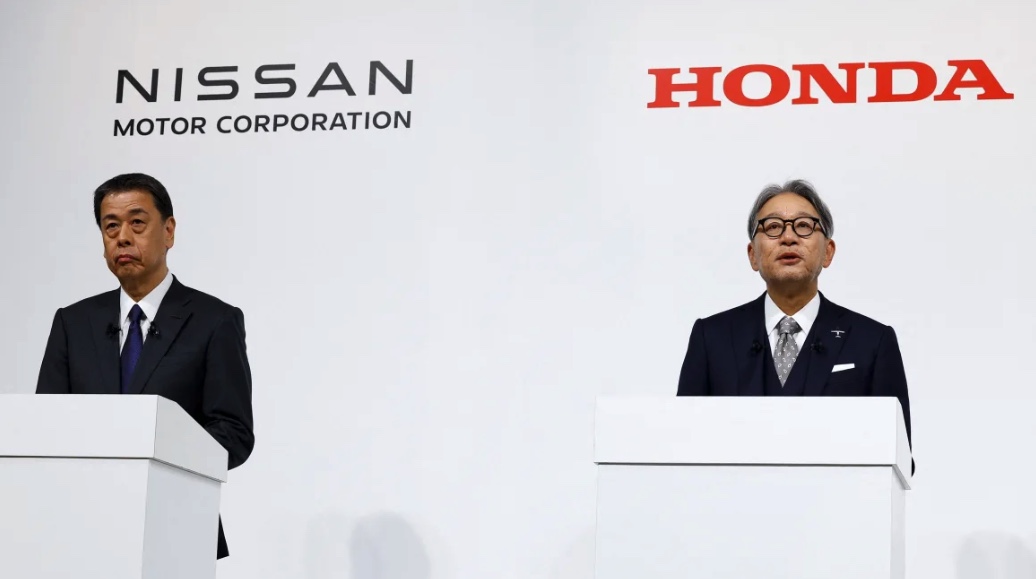Nissan และ Honda ได้ตกลงที่จะเปิดการเจรจาตลอด 6 เดือนข้างหน้าอย่างเป็นทางการเกี่ยวกับความเป็นไปได้ในการควบรวมกิจการ ซึ่งจะทำให้เกิดบริษัทผู้ผลิตรถยนต์อันดับ 3 ของโลก และช่วยเพิ่มศักยภาพในการแข่งขันกับภัยคุกคามที่เพิ่มขึ้นจากผู้ผลิตรถยนต์จีน
ผู้ผลิตรถยนต์ญี่ปุ่นรายที่สาม คือ Mitsubishi ซึ่งปัจจุบันเป็นพันธมิตรกับ Nissan จะเข้าร่วมในการเจรจานี้ด้วย หากการควบรวมสำเร็จ บริษัทใหม่นี้จะเป็นรองเพียง Toyota และ Volkswagen ในด้านยอดขายทั่วโลก
แม้ว่าการควบรวมกิจการในอุตสาหกรรมยานยนต์จะไม่ใช่เรื่องใหม่ แต่ในอดีตก็มีกรณีที่การรวมตัวกันของพันธมิตรต่างวัฒนธรรมล้มเหลว เช่น Daimler-Benz ที่ซื้อ Chrysler Corp. ในปี 1998 ที่สุดท้ายต้องแยกทางในอีกสิบปีต่อมาทำให้ Chrysler ต้องล้มละลายและขอรับความช่วยเหลือจากรัฐบาล
ขณะเดียวกัน การรวมตัวระหว่าง Chrysler กับ PSA Group ในปี 2001 เพื่อก่อตั้ง Stellantis ก็เจอปัญหาเช่นกันในช่วงปีที่ผ่านมา โดยยอดขายและกำไรลดลง นอกจากนี้ พันธมิตรระหว่าง Nissan และ Renault ที่ไม่ใช่การควบรวมอย่างเป็นทางการ ก็ล่มสลายลงหลังจากการจับกุม Carlos Ghosn ซีอีโอของ Nissan ในญี่ปุ่น ด้วยข้อหาทุจริตทางการเงิน
การควบรวมระหว่าง Honda และ Nissan ครั้งนี้เกิดขึ้นท่ามกลางความท้าทายในการเปลี่ยนผ่านจากรถยนต์เครื่องยนต์สันดาปไปสู่รถยนต์ไฟฟ้า รวมถึงการแข่งขันที่เพิ่มขึ้นจากผู้ผลิตรถยนต์จีนที่ก้าวหน้ากว่าผู้ผลิตตะวันตกส่วนใหญ่ในด้านนี้
Makoto Uchida ซีอีโอของ Nissan กล่าวว่า “วันนี้ถือเป็นช่วงเวลาสำคัญสำหรับเรา เราสามารถสร้างประสบการณ์ที่แตกต่างให้กับลูกค้าได้ ซึ่งทั้งสองบริษัทไม่อาจทำได้เพียงลำพัง”
Nissan ประสบปัญหาทางการเงินอย่างหนักหลังพันธมิตรกับ Renault ล่มสลาย โดยผลกำไรในช่วง 6 เดือนที่สิ้นสุดในเดือนกันยายนลดลงถึง 94% เมื่อเทียบกับช่วงเดียวกันในปี 2023 บริษัทต้องลดกำลังการผลิตลง 20% ส่งผลให้มีการปลดพนักงาน 9,000 คน และปรับลดการคาดการณ์กำไรจากการดำเนินงานประจำปีลง 70%
นักวิเคราะห์บางรายคาดการณ์ว่า Nissan อาจต้องเผชิญกับภาวะล้มละลายภายในปี 2026 เมื่อหนี้จำนวนมหาศาลครบกำหนดชำระ
Adam Jonas นักวิเคราะห์จาก Morgan Stanley ระบุว่า การควบรวมระหว่าง Honda และ Nissan อาจนำไปสู่การควบรวมเพิ่มเติมในอนาคตในอุตสาหกรรมยานยนต์
“บริษัทผู้ผลิตรถยนต์ที่ไม่หาพันธมิตรใหม่จะต้องเผชิญกับการเป็นบริษัทขนาดเล็กที่มีต้นทุนการวิจัยและพัฒนา รวมถึงการใช้ทุนสูงต่อจำนวนรถที่ขายได้” Jonas กล่าว
“เราเข้าสู่ยุคใหม่ของอุตสาหกรรมยานยนต์ ซึ่งกลยุทธ์ในการขยายขนาดและลดต้นทุนต้องมุ่งเน้นความร่วมมือและการเปลี่ยนแปลงโครงสร้างองค์กร”
Nissan and Honda announce merger plans to create world’s no. 3 automaker

Honda and Nissan have formally agreed to hold talks over the next six months on a possible merger, a deal that would create the world’s third-largest automaker and give them more resources to compete with a growing threat from Chinese carmakers.
A third, smaller Japanese automaker, Mitsubishi, which is already in an alliance with Nissan, will also participate in the talks. The combined company, should it be created, would trail only Toyota (TM) and Volkswagen in global sales.
Mergers in the auto industry are nothing new. They have taken place since the acquisition of various brands formed General Motors (GM) in the first decade of the 20th century. But they sometimes have trouble succeeding bringing together different partners.
German automaker Daimler-Benz agreed to buy Chrysler Corp. in 1998 only for the combined group to be split up a decade later. The newly independent Chrysler went bankrupt and required a federal bailout within two years.
Chrysler’s latest merger, with Europe’s PSA Group in 2001 to form Stellantis, has had its own problems in the last year, with falling sales and profits. And Nissan’s alliance with Renault, while not a formal merger, ended up collapsing following the arrest of Nissan’s CEO Carlos Ghosn in Japan over charges of “significant” financial misconduct. He fled the country before a trial could take place.
But with the cost and challenges of the industry’s efforts to shift from gasoline-powered cars and trucks to electric vehicles and with rising competition from Chinese automakers, which have moved past most Western automakers in those efforts, Honda and Nissan needed to combine resources in order to remain competitive.
“Today marks a pivotal moment,” Nissan CEO Makoto Uchida said in a statement announcing the negotiations. “Together, we can create a unique way for (customers) to enjoy cars that neither company could achieve alone.”
Nissan has struggled since the collapse of its alliance with Renault, facing severe financial problems that put it in desperate need of a larger merger partner.
Profits in six months ending in September plunged 94% compared with the same period in 2023, as the company lost money on auto operations and reported only a narrow profit due to its financing business. In response, Nissan announced it would cut its manufacturing output by 20%, laying off 9,000 workers as a result. It also slashed its forecast for full-year operating profit by 70%.
Some analysts had speculated Nissan could face bankruptcy as soon as 2026 when it has a huge amount of debt coming due.
The Honda-Nissan tie-up could lead to even more mergers in the industry in the future, said Adam Jonas, auto analyst with Morgan Stanley, in a note last week, when news of the talks emerged.
“Legacy auto companies that don’t find new partners must face the prospect of being smaller companies with higher capital expenditures, and research and development costs per (every vehicle sold),” he wrote.
“Moreover, amidst a potentially broader consolidation era, the ones who chose not to participate effectively ‘get smaller.’ We’re entering a new phase of the auto industry where the strategies for scale and cost leadership put the focus on cooperation and potential changes in scope.”
By Chris Isidore, CNN

















